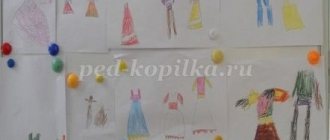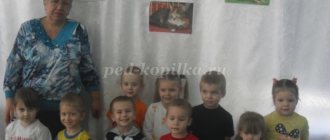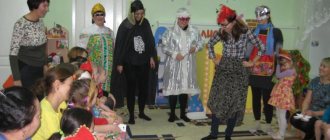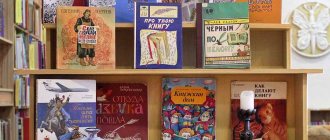Lesson summary “Our planet Earth”
Lesson summary on the topic: “Our planet Earth.”
Author: Bystrova V.V. – teacher
Child Development Center "Skazka"
r.p. Red Buckies
2017
Goals:
- To give children an idea that planet Earth is a huge ball, that it is very large, that most of it is covered with water, there are continents - land; there are many living creatures on the planet, they need clean water, clean air, clean land to live; about environmental pollution.
— Develop a responsible attitude towards the environment.
— Cultivate a love for nature and respect for it.
Preparatory work:
Classes and conversations about planet Earth and the surrounding nature; about the place of man in nature; about human interaction with nature; about the need to preserve and protect nature. Reading poems, proverbs, sayings, riddles about nature. Drawing, applique, modeling.
Materials and equipment:
Map, globe, pointer.
Progress of the lesson:
Q: Good morning, dear children,
You are the most beautiful in the world!
D: (they say hello).
Q: Today, guys, we have a very amazing conversation! Sit back, I'll tell you something.
You and I live on a wonderful planet, it’s called...
D: Earth!
Q: Yes, that's right! What is it like, our Earth?
D: Beautiful, blue, big, unusual, etc.
Q: Imagine that you are astronauts flying in a rocket, what does our Earth look like in space?
The children are talking.
Q: Our planet is a huge, enormous ball; it takes many, many days, even months, to go around it.
Showing the globe.
Q: What is there on our planet?
Children's answers.
Q: First of all, there are two poles on our planet. What are their names?
Children's answers.
Q: One is northern, the other is southern. The northern one is on top of the globe, the southern one is below.
What else is there on our planet?
Children's answers.
Q: Most of the earth is covered with water - these are seas and oceans. Have you heard about them? Maybe you know what the seas and oceans are called?
Blue color on the globe represents water. What else is there on our planet?
The children answer.
Q: Among the oceans there are large areas of solid land - continents, land. This is the largest continent - Eurasia. This continent is located in the northern part of the globe, closer to the north pole. Here is another continent - Africa. Do you know anything about Africa?
Children's answers.
Q: Africa is located in the middle of the globe, a little closer to the south pole. Now I will show you a very interesting, long land, consisting of two parts. Both of them are connected by a narrow strip, similar to a thin neck. Does anyone know the name of this continent? This is America, guys. It consists of two parts: the upper one is North America, the lower one is South America. These continents stretch across the globe, from the north pole to the south.
Who knows what is at the poles of the globe?
Both poles are the coldest places on earth. There is no land at the North Pole, there is an ocean there, it is always covered with ice. That’s what it’s called – the Arctic Ocean. The south pole is even colder than the north pole. There is land there - the continent of Antarctica.
The last continent remains. It is the smallest - it is Australia. This continent, like a large island, is surrounded on all sides by the ocean.
Look carefully, guys, at our map, or at the globe. What does the globe look like? What is more on our planet Earth, water or land?
Children's answers
Q: Yes, there is much more water, oceans and seas. Who lives in the seas and oceans? Does anyone live on land? Who?
Children's reasoning
Q: Of course, on all continents there are a lot of living beings: plants grow, large and small animals and people live. Many different peoples live on all continents. Only one landmass is uninhabited - Antarctica. Due to the extreme cold, plants do not grow there, and people do not live there permanently either. Only a few animals live in coastal ocean waters.
Q: If the seas and oceans are depicted in blue, then the land, where it is always covered with snow, is white. Wherever it is not too cold and not too hot, many green plants grow, which is why most of the land is depicted in green.
The middle part of the globe is very hot all year round. Is it hot or cold in Africa?
Children answer
B: Yes, it is very hot there. Africa has many deserts covered with sand, practically no water and very few plants. That's why most of Africa is shaded yellow. The south of North America is also full of deserts.
Now you and I know where the poles are on the globe, where the continents are, and where the water is - oceans and seas. This is how colorful our Earth is!
Physical education minute
Q: Where on Earth do you and I live? Where is our continent, where is the place on it that our village occupies? What is it called?
Children's answers
What is the name of our state?
Our state, Russia, is located on this continent (shows on the map). Our country is large and takes up a lot of space on the map. Who knows what the main city in Russia is called?
Answers
That's right, Moscow, look where it is. And here is our village.
Q: Now, guys, I’ll tell you the most important thing! Our planet Earth is in danger! There are many sore spots on it. This happened because people built many plants and factories, power plants, nuclear power plants. These enterprises pollute the air - it is polluted by the smoke that comes out of the chimneys into the sky, and gases from cars. Waste from factories is discharged into rivers and seas and pollutes them; oil from tankers spills into the waters of the seas and oceans during accidents. This is how our planet Earth is polluted, and from this pollution animals and plants die, people get sick. Nature is dying! Our planet Earth is in danger, it must be saved through common efforts.
How can you and I help our planet?
Children's reasoning
To help, you need to learn to love nature, to love it from childhood. Learn to understand how all living beings live: birds, bugs, animals, flowers, blades of grass. This is done by people called ecologists. Do you want to become little ecologists?
Then you and I will try to preserve and protect nature, help living beings, and do good deeds.
I will now show you two places in our country that need to be saved. Far away in Siberia there is Lake Baikal. This is a very beautiful lake. Now it is polluted. People not only in our country, but also in other countries are thinking about how to save it. Look where it is on the globe. Still far from us in the south of our country there is the Aral Sea. There is another problem with it, the water in it becomes less and less every year, it dries out. Now people are also thinking about how to save him.
Do you think our village is in danger?
Q: The biggest problem in our village is garbage! Yes, guys, you noticed correctly, garbage is everywhere, in the forest, on the banks of springs, rivers, near houses.
Guys, please talk to your parents, what is threatening our village and how can we help it?
Children ask questions
Q: You know, guys, I watched you during our lesson and realized that you were very interested in this topic. I will be glad to go with you on a great journey around our planet Earth, and we will answer your main questions: “Why is our planet Earth called the globe?” and “What to do with garbage?” Goodbye, see you again.
lesson notes “Planet Earth” lesson plan on the world around us (preparatory group)
Lesson summary for the preparatory group “Planet Earth”
Priority educational area: cognitive development. Integrated areas: speech development, socio-communicative development, physical development, artistic and aesthetic development. Purpose: to give children an idea of the uniqueness of planet Earth. Develop cognitive interests and the need for independent search activities.
| Integration of educational areas | Tasks |
| Cognitive development | To form an idea of planet Earth and the living conditions on it. Develop logical thinking, visual memory, holistic perception and voluntary attention. |
| Speech development | Develop coherent dialogic and monologue speech. Induce speech activity in a child through play. Foster love and interest in the artistic word. |
| Social and communicative development | Foster a sense of pride for your planet. To develop children's environmental awareness and to instill a desire to protect their planet and nature. Teach children to think, justify their opinions, formulate and summarize the results of experiments, interact with each other and with adults. |
| Artistic and aesthetic development | To form an aesthetic attitude towards the surrounding world, the natural world. Perception of fiction. |
| Physical development | Develop coordination of movements, attention, speed of reaction. Relieving emotional stress. |
Methods and techniques: visual, verbal, practical. Types of children's activities: play, communication, cognitive research, perception of fiction. Preliminary work: looking at a map, globe, reading fiction and scientific literature, watching presentations and videos on the topic. Materials and equipment:
- Globe, laptop, screen
- Subject pictures depicting the Earth in outer space and rules of behavior in nature.
Logic of educational activities
Educator:
Hello, golden sun. Hello, the sky is blue. Hello, free breeze. Hello, my dear friend. We live in the same region, I greet you all.
Educator: Guys, I’ll now tell you a riddle and you’ll find out what we’re going to talk about today:
The planet is blue, Beloved, dear, It is yours, it is mine, And it is called... (earth) Children: Earth.
Our Earth is a blue planet, clothed with fresh air and sun. No, believe me, the Land of Doves From the blue of rivers, lakes and seas. Mountains, plains, forests and fields - All this is our planet Earth. The winds sing, playing with the clouds, The showers make noise... And from edge to edge you will not find our beautiful and kind planet more wonderful in the world!!!
Educator: (pictures depicting the Earth in outer space on the screen) Our planet is a huge, enormous ball. So big that it takes many, many days, even months, to travel around it. She's round like an apple. The Earth revolves around the Sun, like an airplane around a turret. Moreover, it itself rotates around its own axis, spinning like a top, only slowly. The Earth is a satellite of the Sun. It is much smaller than the Sun. Together with our planet, eight other planets revolve around the Sun. But only on our Earth there is life. Teacher: puts the globe on the table. What is it? Children: A globe is a tiny model of the globe. It shows what is on the real Earth: oceans and land. Educator: You see that the globe rotates around its axis. (Rotates the globe.) The Earth rotates in the same way. The Earth exposes the Sun to one side or the other. So they say: “Day and night - a day away!” Is there air on earth? (Asks the children to show on the globe the air shell of the Earth - the atmosphere). Who needs air to breathe? What is he like? Children: There is air on Earth, everyone needs it: humans, plants, animals. Air surrounds us everywhere, it is invisible. Educator Is there water on Earth? Notice that there is a lot of blue on the globe. What does this mean? Children: water. Children show oceans, rivers and lakes on the globe. Educator: Yes, we have many rivers, seas and oceans. And who needs water? Children: Humans, animals, birds, plants, trees. Educator: Yes, there is not a single organism on Earth that could live without water. The teacher explains that there are places where there is little water (desert, How is life there (difficult) Educator: And now we will play the game “Four Elements”. If I say the word “earth”, everyone should put their hands down if I say the word “water”, then stretch your arms forward, on the word “air” - raise your arms up, on the word “fire” - rotate your arms in the wrist and elbow joints. Whoever makes a mistake is considered a loser. Educator: In what places is there fresh water? Children: In rivers, in lakes. Educator: In what places on our planet is there a lot of water? Show it on the globe. Children: in oceans and seas. Educator:: guess the riddle: “there is water all around, there’s trouble quenching thirst.”
Children: Sea. It is impossible to quench your thirst, because it is bitterly salty. Educator: Yes, that’s right, the most important thing is that it’s salty. And we drink plain water. Fizminutka:
I raise my hands to the sun and breathe in and breathe in. Well, I lower my hands and quietly exhale the air. (We raise our arms up through our sides, inhaling through our nose. We lower our hands through our sides and quietly say as we exhale: “F - F - F”) Educator: So guys. There is a lot of water on our planet Earth, but land takes up very little space and is represented by darker colors, yellow and brown. And the land is presented in the form of continents. There are only 6 of them. Name them for me Children: Eurasia, Australia, Africa, Antarctica, South America and North America. (show on the globe) Educator: All these continents are covered with soil, grass, forests grow on them, in which animals, insects and birds live . Is it warm or cold on our planet? Which places on Earth are especially cold (children show the polar zones on the globe: the Arctic and Antarctic) Who lives there? How do animals, plants and people adapt to cold weather? Which places are very hot? (desert). What places are not very hot and not very cold? (steppes, forest-steppes, forests).
And what is the largest animal of all on earth. It is larger than 3 dinosaurs and weighs as much as 33 African elephants? (blue whale)
It tolerates harsh climates, frosts and drought well. In summer he can withstand 5 days without water, and in winter 20. After such a long thirst, he drinks up to 120 liters of water? ( camel)
And now we will remember what we must do so that the beauty of our planet Earth does not disappear. Let's play the game “Rules of behavior in nature.” I will tell you the actions, if they are good, you say “Yes.” If the actions are wrong, answer “No”. If I come to the forest and pick a daisy? (no) If I eat a pie And throw away the piece of paper (no) If I leave a piece of bread On a stump (yes) If I tie a branch I put a peg (yes) If I make a fire But I don’t put it out? (no) What if I mess up a lot and forget to clean it up? (no) If I pick up the trash I’ll bury the can (yes) I love my nature I help her (yes)
Educator: We are walking down the street, carrying a bag of garbage.
One piece of paper, two pieces of paper, throw it all in the compartment
Plastic, jar, blotter, all in the basket or not?
Let's say the correct answer, do you collect all the garbage together? NO
Why is it worth separating garbage collection?
Earth is the only planet in the solar system where there are all conditions for life. You can live on planet Earth because it is not so hot and not so cold, there is air - you can breathe, there is fresh water - you can drink, there is something to eat.
There is one garden planet in this cold space. Only here the forests are noisy, calling migrating birds, only here they bloom, lilies of the valley in the green grass, and only here dragonflies look into the river in surprise. Take care of your planet - After all, there is no other like it!
The teacher reminds the children that the birthday of planet Earth is coming soon - April 22.





